Research activities of AG Wende
Research in the AG Wende focuses on magnetic nanostructures. Our main goal is the investigation of their electronic and geometrical structure as well as their magnetic properties mainly by element-specific methods such as X-ray absorption and Mössbauer spectroscopy. We apply these methods to a wide variety of topics, a few examples of which are described below.
Magnetic Molecules
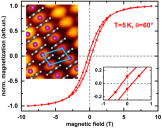
Organometallic Nanowires
Compounds in which the spin of a 3d or 4f metal is coupled to an organic molecule are highly interesting materials for future spintronic applications such as spin filters. Rare earth cyclooctatetraene nanowires are promising candidates for such applications. With the help of X-ray absorption spectroscopy (XAS) and magnetic X-ray circular dichroism (XMCD), we are able to observe the electronic structure as well as the magnetic moments and their coupling element-specifically, even for very low coverage rates (<10% of an atomic monolayer). Our goal is the synthesis of new compounds via the variation of metals and ligands, which bring us closer to applications through improved magnetic and electronic properties.
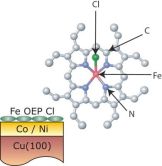
Porphyrins
Organic molecules with a magnetic central ion are adsorbed on metallic substrates. X-ray absorption spectroscopy (XAS) reveals the adsorption geometry and by X-ray magnetic circular dichroism (XMCD) switching of the magnetic moment of the central magnetic ion is observed. The figure shows a Fe porphyrin molecule as an example of a magnetic molecule. These Fe porphyrins represent an organometallic complex that provides relevant biological functionality, e.g. in the hemoglobin (red blood cells) and chlorophyll (green color of leaves).
Nanoparticles
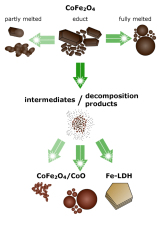
Mixed Oxide Catalysts
In the scope of the TRR/CRC 247, nanoscale mixed oxide catalysts such as cobalt ferrite (CoFe2O4) are examined for their application in electrolysis (oxygen evolution reaction). For this purpose, the catalytic activity of these materials is determined (AK Prof. Behrens), which depends strongly on the particle size and the composition of the material. We then apply our element-specific methods, such as Mössbauer spectroscopy and X-ray absorption spectroscopy (XAS, XMCD) to probe the local magnetic properties of these catalysts. Additionally, the macroscopic magnetic characteristics are analyzed via VSM and SQUID magnetometry. Aside from the pre-characterization of precursor materials to improve particle synthesis, we also combine our methods with optimization approaches such as pulsed laser fragmentation, determining its influence on particle size, morphology, and catalytic activity. Furthermore, we prepare epitaxial thin film oxide samples via pulsed laser deposition (PLD), which are utilized as well-defined model systems for catalysis experiments within the TRR/CRC 247.
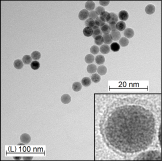
Iron-Oxide Nanoparticles
Iron oxides are of great interest for research, especially in medicine, due to their biocompatibility for magnetic resonance imaging, as well as for various cancer treatment approaches.
Due to their different forms of appearance (magnetite, maghemite, hematite, etc.) and the strong size dependence of their properties, such nanoparticles are also of high importance for basic research, allowing insights into the foundations of magnetism. They are characterized in our group with regards to their macroscopic magnetic properties via magnetometry, while the local properties are evaluated with element-specific methods such as X-ray absorption and Mössbauer spectroscopy. Additionally, such particles can also be used to form functional magnetic hybrid materials by combining them with gels or fluids (outlined below).
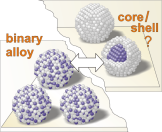
Fe-Pt-Alloys
Particles with diameters of a few nanometers give the possibility to study the properties of the material between bulk characteristics and properties of atomic or molecular structures. In our research, we focus on the magnetic properties of nanoparticles consisting of pure metals, metal oxides, or ferromagnetic alloys. By means of x-ray magnetic circular dichroism (XMCD) the magnetic moments can be determined element-specifically and orbital and spin magnetic moments can be separated. In addition, the structure and local composition can be analyzed by X-ray spectroscopy. Thus, it was found that the composition of FePt nanoparticles is inhomogeneous yielding reduced magnetic moments compared to the corresponding bulk material. An extreme example of such inhomogeneities in binary systems, core/shell particles, is a prospective topic: The particles are composed of a one-element core, whereas the shell consists of another chemical element. This does not only protect the particle's core from oxidation and other aging effects but may also facilitate e.g. bio-functionalization for medical applications.
Magnetic Thin Films and Heterostructures
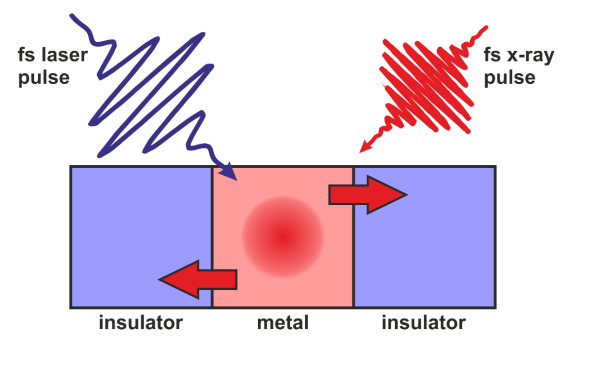
Femtosecond Time-Resolved Soft X-Ray Spectroscopy
A local laser-excitation of a metal-insulator heterostructure leads to it being in a strong non-equilibrium state. But which microscopic process is responsible for the return of such a system to the equilibrium state within the first few hundred femtoseconds? By the combination of the element-specific character of X-ray absorption spectroscopy with femtosecond time resolution, we are able to obtain a local characterization method, which is sensitive to the dynamics of individual constituents of the heterostructure.
Within the CRC 1242, joint projects with the groups Bovensiepen, Pentcheva, and Wende combine femtosecond time-resolved X-ray absorption experiments with ultrafast electron diffraction and ab-initio theory. This enables us to disentangle the dynamics of different electron and phonon systems of such a heterostructure, and observe the redistribution of the initially deposited energy.
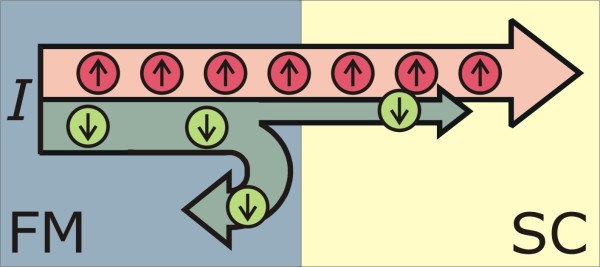
Ferromagnet/Semiconductor Interfaces for Spin Injection
Ferromagnet/semiconductor interfaces play a crucial role when exploiting the magnetic spin of the electron in addition to its charge as a carrier of information in new spintronic devices. Spin-polarized currents have to be created and injected into semiconducting materials that provide the basic functionality of modern electronic devices.
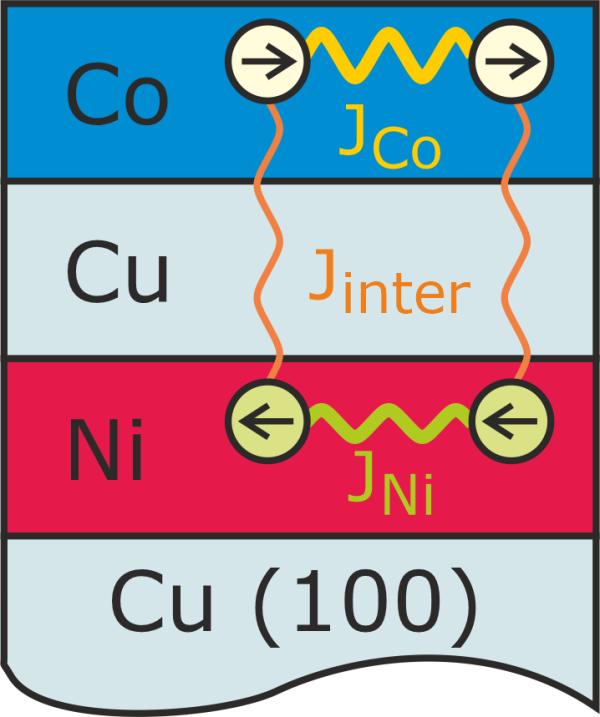
FM/NM/FM Coupling Phenomena
Two ferromagnetic layers (FM) separated by a nonmagnetic spacer layer (NM) form the prototype structure that finally lead to the Nobel prize in physics in 2007: the discovery of the giant magneto-resistance effect. Besides that, these multilayer structures exhibit a variety of coupling phenomena across the NM spacer layer. In addition to the samples where the nonmagnetic layer used to be a metal, new experiments incorporate a semiconductor such as silicon as the NM spacer layer.
Magnetocaloric Effect
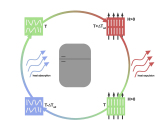
Element-Specific Characterization of Magnetocaloric Materials
Due to the ever-increasing global demand for cooling, new concepts to replace the classic gas compressor cycle have become highly attractive for research. One concept is represented by magnetocalorics, which is a class of materials that can be utilized for solid-state refrigeration.
Such materials typically feature a significant adiabatic temperature change, caused by magnetic fields, as well as a high isothermal entropy change. When exceeding a critical temperature, the phase transition temperature, the material goes through a first-order phase transition, accompanied by a drastic volume change, caused by the magnetic phase change. In our group, these processes are characterized in detail using methods of X-ray absorption (XAS, XMCD, EXAFS) and scattering (NRIXS), enabling the analysis of element-specific contributions to magnetic, structural, and vibrational properties. With this approach, promising materials can be examined with regard to their magnetocaloric characteristics, and their suitability for solid-state refrigeration applications.
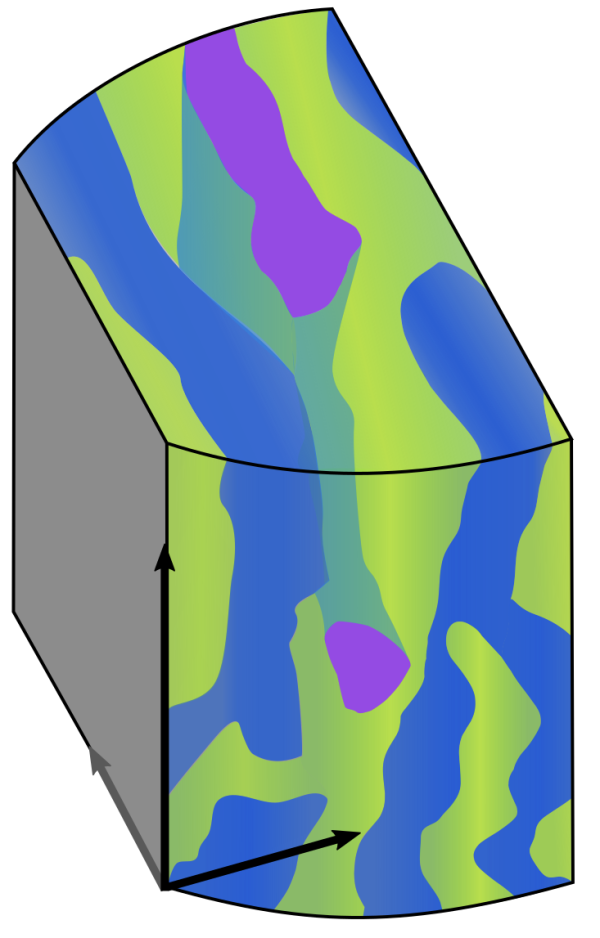
Permanent Magnets
Permanent magnets are at the heart of green energy production and an essential component in many modern technologies, but there is ongoing research aimed at improving their performance and reducing their cost. One current research question is the development of magnets with higher magnetic energy products, measuring the magnetic energy that a material can store per unit volume. This can be achieved by using new materials, optimizing the microstructure of the magnet, and improving fabrication techniques. Another research question is the development of rare-earth-free magnets, as rare-earth elements are expensive and environmentally problematic to mine and process. In our group, we utilize advanced techniques such as X-ray absorption (XAS, XMCD, EXAFS) and tomography-based techniques to analyze element-specific contributions to the magnetic, structural, and microstructural properties of these materials to decipher the DNA of magnetic hysteresis.
Multiferroics
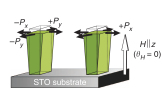
Magnetoelectric Composites
Materials that couple magnetic and electric properties are highly attractive for application purposes, such as for sensors, actuators, storage media etc. One usually distinguishes between single-phase materials and multiphase composites, with the latter offering more opportunities for optimization.
A well-known system combines cobalt ferrite with barium titanate (CFO-BTO), a magnetostrictive and a piezoelectric material. By inducing a deformation of one constituent through electric/magnetic fields, a strain can be transferred to the other. By this method, a material can be magnetized via the application of electric fields or polarized by the application of magnetic fields. The characterization and optimization of such functional material systems are performed with a specialized setup, which is able to directly measure the converse magnetoelectric effect.
Magnetic Hybrid Systems
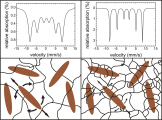
Particle-Matrix Interaction in Soft-Matter Composites
Hybrid materials, formed from magnetic nanoparticles combined with viscous or (vicso-) elastic media, allow direct control over their material properties via magnetic stimuli and are promising for applications in medicine, damper systems, sensors and actuators, and many other fields.
To examine the influence of different nanoscale surroundings and structures in gels, elastomers, liquid crystals, etc. on the alignment behavior and dynamics of particles, and to form highly advanced material systems for applications, we use a combination of magnetometry and AC-susceptometry, along with element-specific Mössbauer spectroscopy. Especially the latter provides information on both spin alignment and relaxation behavior, magnetic structure, and Brownian dynamics of the particles, and thus allows simultaneous important conclusions about the interaction of particles and the surrounding matrix, as well as fundamental matrix properties.
Astrophysics

Planetesimal Formation
In cooperation with the group of Prof. Gerhard Wurm, we examined the material also found during planetesimal formation. For this purpose, meteorite material was used, which represents the properties of the original protoplanetary disk. After heating such samples for extended periods of time, the resulting material was analyzed via magnetometry, and element-specifically with Mössbauer spectroscopy, to detect any changes of chemical composition due to the experimental conditions (temperature, pressure, atmospheric composition), which were chosen to approximate those found in a protoplanetary disk. Further experiments were also performed with Mars analog samples (Mars regolith simulant JSC-Mars-1A), to simulate the chemical and mechanical properties of the Martian surface.
